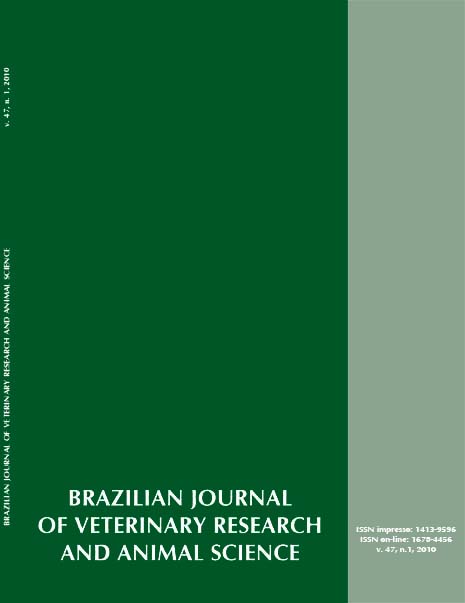Immunological and genetic study of 10 bat rabies virus isolates from Rio de Janeiro State, Southeast Brazil
DOI:
https://doi.org/10.11606/issn.1678-4456.bjvras.2010.26851Keywords:
Rabies virus, Rabies vaccine, Vaccine Potency, Bats, PhylogenyAbstract
In the present study we analyzed ten bats rabies viruses isolated from Rio de Janeiro State, focusing on its genetic characteristics from genes N and G, and also in the response of mice vaccinated with cell-culture rabies vaccine, produced with the Pitman-Moore strain, after viral challenge with bat rabies isolates, using an immunologic essay based on NIH vaccine potency test. The vaccine used conferred protection in more than 80% of the mice vaccinated with 1:15 vaccine dilution, after viral challenge. N gene genetic analysis divided the rabies virus isolates into haematophagous and insectivorous bat variants, with all isolates from Artibeus sp. frugivorous bats being clustered with the variant characteristic of the Desmodus rotundus vampire bat. Phylogenetic differences between isolates from Northeast Region and those from the Metropolitan and South Regions of Rio de Janeiro State were observed. The substitution of an aspartic acid to a glutamic acid found in the position 118 of G gene genetic characterization from samples 704/97BR-DR and 151/98BR-DR seems to be related to viral antigenicity. There were no time-related genetic differences between the studied samples. The vaccine employed was found with satisfactory protection against the majority of the isolates used.Downloads
Download data is not yet available.
Downloads
Published
2010-02-01
Issue
Section
UNDEFINIED
License
The journal content is authorized under the Creative Commons BY-NC-SA license (summary of the license: https://
How to Cite
1.
Mota C da S, Ito FH, Silva MV, Sato G, Kobayashi Y, Itou T, et al. Immunological and genetic study of 10 bat rabies virus isolates from Rio de Janeiro State, Southeast Brazil. Braz. J. Vet. Res. Anim. Sci. [Internet]. 2010 Feb. 1 [cited 2024 Apr. 23];47(1):74-85. Available from: https://revistas.usp.br/bjvras/article/view/26851





